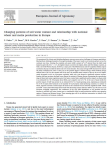Pinke Z., Decsi B., Kardos M.K., Kern Z., Kozma Z., Pásztor L., Ács T. (2022). Changing patterns of soil water content and relationship with national wheat and maize production in Europe. European Journal of Agronomy, 01/10/2022, vol. 140, p. 1-11.
https://doi.org/10.1016/j.eja.2022.126579
https://doi.org/10.1016/j.eja.2022.126579
| Titre : | Changing patterns of soil water content and relationship with national wheat and maize production in Europe (2022) |
| Auteurs : | Z. Pinke ; B. Decsi ; M.K. Kardos ; Z. Kern ; Z. Kozma ; L. Pásztor ; T. Ács |
| Type de document : | Article |
| Dans : | European Journal of Agronomy (vol. 140, October 2022) |
| Article en page(s) : | p. 1-11 |
| Langues : | Anglais |
| Langues du résumé : | Anglais |
| Catégories : |
Catégories principales 07 - ENVIRONNEMENT ; 7.3 - Eau. Gestion de l'EauThésaurus IAMM TENEUR EN EAU ; SOL ; CHANGEMENT CLIMATIQUE ; CARTOGRAPHIE ; RENDEMENT DES CULTURES ; CEREALE ; CEREALICULTURE ; MAIS ; BLE ; EUROPE |
| Résumé : | The warming of the climate and shrinking freshwater resources pose serious challenges to European agriculture. Meeting these challenges demands a thorough knowledge of the major trends in soil moisture patterns across the continent over time. Charting the available soil water (ASW) content (m3 m-3) derived from the ERA5 Land dataset in grid cells of 0.1° * 0.1°, the highest values occurred in the Alpine, Baltic and West Balkan countries, as well as in North Western Europe. However, a major part of the Mediterranean and the Carpathian-Balkan regions and Eastern Europe recorded the driest soils over recent decades. The annual average ASW decreased over almost the entire continent from 1981 to 2007, but to the greatest degree in Eastern Europe, while Northern Europe suffered least of all. For the summer half of the year, the available water content of the top 28 cm soil significantly decreased in 45.5 % of European croplands, while only 1.0% showed a significant moisture increase. Summer half-year moisture declined across almost the entirety of Eastern Europe, threatening the reproductive stage of wheat and maize vegetation period. Soil water content had a significant positive impact on wheat yields in an estimated 64.3 % of European wheat fields, and a negative one in 5.7 %. In the case of maize yields the positive impact of ASW was present in an estimated 89.4 % of maize-growing areas, explaining an estimated 46?72 % of maize yield variances in the majority of top European maize-producing countries. In contrast to wheat, negative soil water content impact for maize in the continent was not observed. Significant ASW - wheat and ASW - maize yield relationships were found with decreasing summer half year ASW in 32.0 % and 35.2 % of European croplands, respectively. The coexistence of the crop yield dependence on soil moisture and the decrease in available soil water content pose a considerable threat to grain production stability over extensive regions of Eastern and Western Europe. These warning signs call for an effective intervention on behalf of soil water conservation in European croplands. |
| Cote : | En ligne |
| URL / DOI : | https://doi.org/10.1016/j.eja.2022.126579 |







